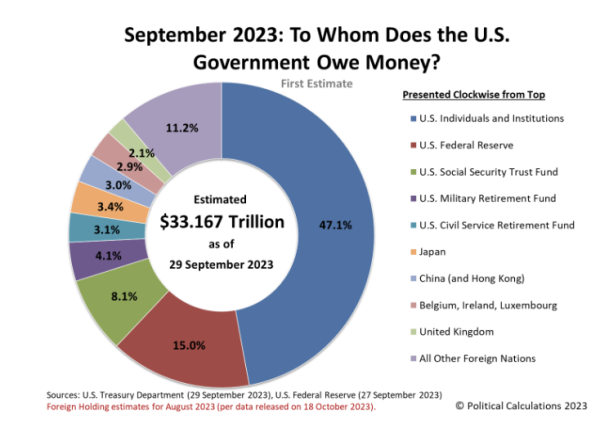If you had 34 trillion one dollar bills and laid them end to end at the equator, they would wrap around the planet over 132,000 times. This is the current amount of debt that the United States government has. However, is the national debt really as bad as it appears? The Carroll News reached out to Dr. Marius Mihai of John Carroll’s Economics and Finance Department to answer this question, as well as some others pertaining to the national debt.
The national debt is the amount of money the U.S. government has borrowed to cover its expenses over time. In a year when government spending exceeds government revenue (collected usually in the form of taxes), a deficit results. To make up for the deficit the federal government sells Treasury bonds, bills and notes to investors who will earn interest on these investments. The debt is then the accumulation of this borrowing and the interest accompanied by it. As the government experiences recurring deficits, which has been the case for every year since 2001 according to the U.S Department of the Treasury, the national debt grows.
So why doesn’t the U.S. government increase or rewrite the tax codes to account for the deficit, eliminating some of the loopholes utilized by large corporations and wealthy individuals? When asked about this Dr. Mihai said, “While increasing taxes on large corporations and individuals would likely increase the government revenue, there are significant negative repercussions in doing so such as economic regression in terms of GDP (gross domestic product).” To Dr. Mihai the simpler option is for “Congress to be more transparent as to where money is being spent, be more responsible by reducing government spending in certain areas and become more efficient as a result.”
Since its founding, the U.S. has almost always had national debt. In fact, one of the founding fathers, Alexander Hamilton, believed that putting a certain percentage of government revenues toward the debt but not paying it all off was a necessity to help the economy grow. The only time the debt was ever paid off was in 1835 by President Andrew Jackson which he did by selling off government land and vetoing spending bills passed by Congress.
Over the last century, the national debt has grown exponentially and has absolutely exploded during the 21st century. At the close of World War I, the national debt was approximately $22 billion, and today the debt sits at just over $34 trillion.
When asked what factors have contributed to the national debt Dr. Mihai stated, “Historically the funding or fighting of wars has contributed a great deal to the national debt, however more recently the Great Recession of 2008-2009 and the Covid-19 Pandemic have significantly raised it.”
This is because of the unexpected shockwave that these two events sent through the economy, and the government was required to intervene to try to get things back on track. During the pandemic government spending increased by over 50% largely because of the stimulus checks.
The national debt does not include any state or local government debt, nor does it include individual consumer debt if it did the number would be over $66 trillion. However, about 80% of the debt is publicly owned and approximately the other 20% is considered to be intragovernmental debt which is technically money the government owes itself. A breakdown of who owns the debt is pictured in this chart below.

The Debt Ceiling is a limit imposed by Congress on the amount of outstanding debt the government can have. Once the debt ceiling is reached, the federal government can not increase the amount of outstanding debt, however Congress can raise the debt ceiling which they have done 78 separate times since 1960 according to Time Magazine. If the debt ceiling fails to be raised, which has never happened, and the US government fails to repay the interest on its debt, it would send a shock throughout the economic world.
Dr. Mihai indicated that “… the debt ceiling should be removed because it is being manipulated in a manner to obtain political leverage by both sides, and the inability to come to an agreement to raise it poses a massive threat… [an]Inability to raise it would likely cause the U.S. economy to default, sending earthquakes throughout global economies.”
A better indicator of the burden of a country’s national debt can be made by comparing a country’s debt to its GDP. This reveals a particular country’s ability to pay down its debt, and is far better than just examining the debt itself. For example, in 2023 the US debt ($33 trillion) to GDP ($27 trillion) which is a ratio around 120%.
When asked if this ratio is concerning Dr. Mihai stated “That the U.S. has the ability to run a higher debt to GDP ratio than many developing countries, but has a comparable debt to GDP ratio to many other developed countries such as France 111% and not nearly as high as Japan’s 215%.”
Dr. Mihai concluded by saying “While the national debt is always portrayed as a crisis, it is the job of economists to explain to the general public that looking at the debt alone is not a proper evaluation of the economy. The debt should always be compared to GDP to see economic growth. The public also needs to comprehend that it is difficult to reduce government spending in many areas without hurting economic growth. For the foreseeable future, as the high interest rates eventually begin to come down, and through proper management, it does not appear like the national debt holds any immediate threat to the U.S. dollar or for that matter the world economy.”
While Alexander Hamilton may not have expected the national debt to reach $34 trillion and there are definitely many problems that need to be addressed, the government’s national debt allows it to remain functioning and allows for further investment in infrastructure to keep the economy growing.


